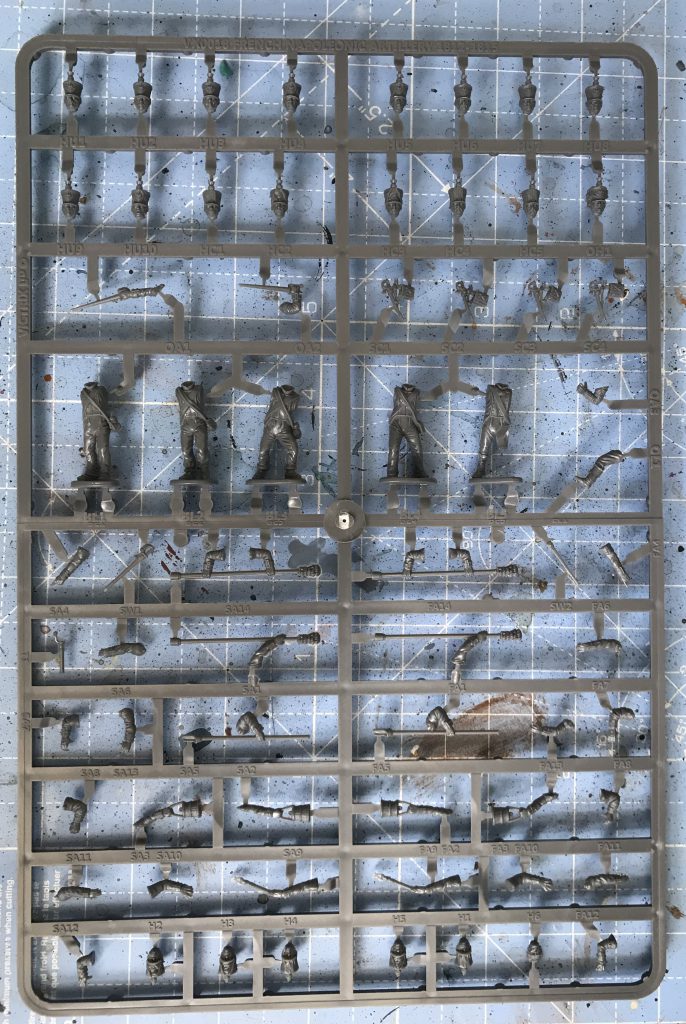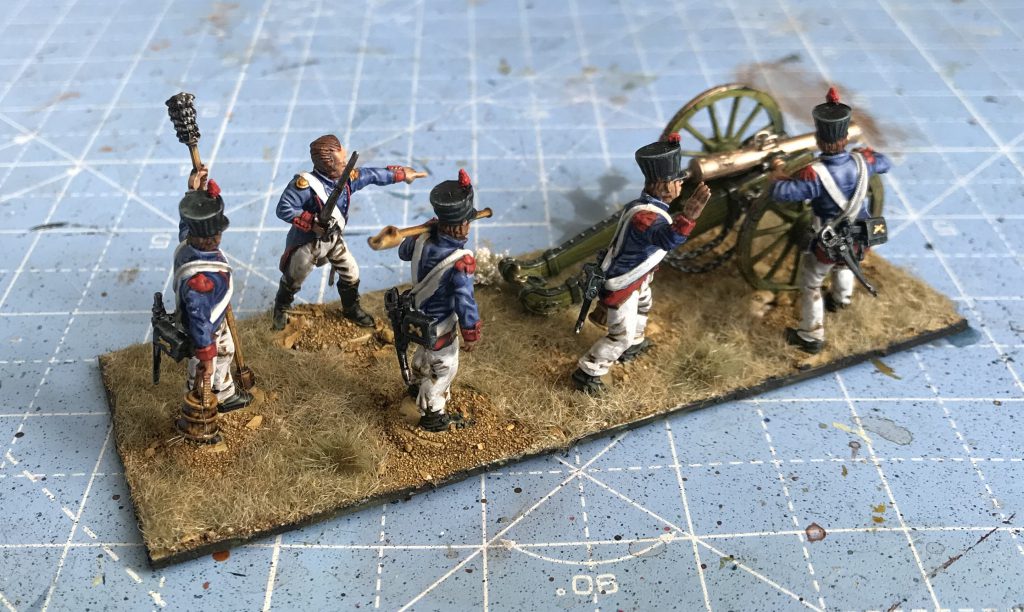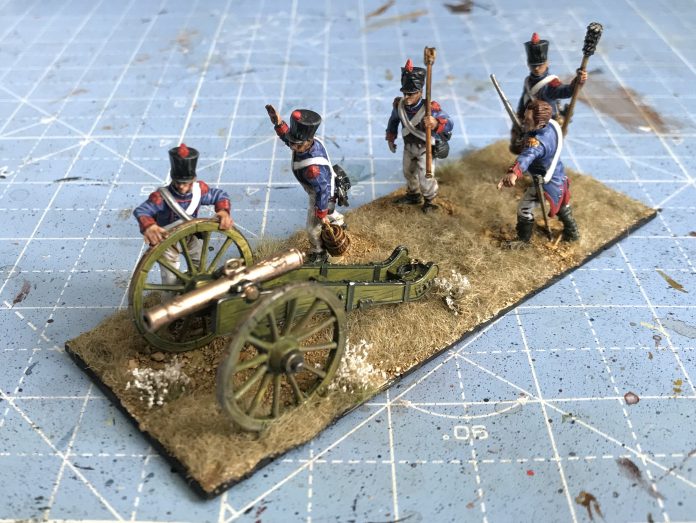For all that Napoleonic miniature sculptors love devoting time and energy to the flamboyant cavalry, the real hero of the battlefield – the “beautiful daughters” of the Big Napoleon Himself – are the guns. There’s something quintessentially Napoleonic about artillery of the period that makes them stand out even amidst the world of uniformed miniature flamboyance. Perhaps it’s the brightly coloured carriages, or the bright brassy cannon, the wicker lining the gun-pit, the smell of powder and smoke, the gunner-general screaming at us to follow him into the breach at Little Gibraltar outside Toulon – whatever it is, if you’re playing French Napoleonics, you need guns.
In my opinion the Victrix French Artillery kit is – spoiler for the review below – the best of the possible options for French cannon. The kit itself is impeccable (I am really ruining the tension of the review here), but, if you don’t know your Gribeauval from your Year XI it’s not as simple as it first seems. This article is a review of the French Artillery 1812-1815 kit – but it’s also a guide as to which one of the three French Artillery (the other two are 1804-1812 and 1804-1812 System XI) sets you should be considering for your Corsican Gunner to play with.

The Kits
Each of the three kits gets you three guns, each with five crew, using one sprue for guns and one for men. Each sprue is one of two options:
Guns:
Gribeauval system 8/12lb gun
XI system 6lb gun and howitzer
Crew:
1804-1812 Uniforms
Post 1812 Uniforms
The sprues in the 1812-1815 kit are uniformly excellent, with crisp casting and clear detail. Flash is minimal and mould lines are (largely) not prominent, though some of the pom-poms and shakos required careful cleaning. As always with Victrix kits, the details are delightful – the shako plates, crossbelts, swords and gaiters are all there, with the lovely delicate and human-accurate scaling that Victrix have adopted for their Napoleonic kits. The details on the Shakos particularly are just beautiful – highly detailed eagle plates and roundels which will reward careful painting or contrast-style washes.

The 1812 kit comes with covered and uncovered shakos, several bare heads and options for arms for each piece of gunnery kit between shoulder straps and epaulette fringes. It’s another excellent mark in the kit’s favour, as providing both gives a great degree of flexibility in your modelling. This gives you everything you need to make line (including Officers and First-Class Gunners) or Young Guard artillery, and use of heads from the Victrix Old Guard (Grenadiers) kit or similar will allow you to make up an Old Guard artillery team with the same components. The guns are simple and clean with the appropriate details and a nicely modular system where the connections to the carriage are moulded into the gun – you’ll be able to change between the guns in each set easily, so you can go from light cannon to howitzer whenever you like.

The crew come with a variety of options, allowing you to model them running the gun up – manhandling it into position – or loading, cleaning, and firing. The kit needed to load, clean and fire a gun is all here too, including a number of different options for carrying arms, so your commanders, rammers, ventsmen, firer, senior gunners are easy to model. It’s also – rather obviously – compatibly scaled with the other Victrix kits and even works well with Perry and Warlord components, giving you a massive range of kitbashing if needed to make each gun unique. This is the real advantage of making the gun kit plastic, as you can assemble multiple guns in the same (or different) stage of the firing process without running into duplication or, if you’re mixing manufacturers, different scales. Multipart plastic will let you do a real gun battery, without it becoming the same set of sculpts and, for someone whose plans involve at least a full company of 8 guns for my Young Guard Artillery alone, this is extremely important.
In terms of scale, the kit works extremely well alongside Perry metals, as this comparison with my Old Guard gun shows. I’ve not made this particularly easy by using a different base style, but the men (and gun) are of similar scales, with the slightly more gracile plastics standing a little taller and lighter on their feet than the metals.

This needn’t be a particularly long review really – if you want French (or french-uniformed – Italian, Minor Confederation states, battalion pieces in Swiss regiments etc etc etc) Napoleonic guns and you want a lot of them, you should be getting these kits. It’s high quality, it’s endlessly convertible and posable and it’s an excellent price. The perennial bugbear of some Victrix kits – that the instructions can occasionally be a little inscrutable – doesn’t even apply here, with bodies and arms largely matching together seamlessly.
Which kit to get?
The kits represent a succession of changes in French artillery and uniform organisation, and it delights the ever-growing grognard in me that they’ve been split out into the different sets so that you can absolutely guarantee you’ve got the right men in the right uniforms with the right guns for your army.
It makes a lot of sense to me that Victrix have split off the very different uniforms between the pre-1812 issue (long tails on the habit with underlying veste) and post 1812, the shorter (and imo smarter) habit-veste. Differences in the headgear will satisfy the grognards too, with regulation-appropriate heads in 1812-1815 and pre 1812 sets. The 1804-1812 set has a wider range of heads – bicornes, shakos and bearskins – allowing for a number of different uniform issues including Guard Foot Artillery, while the 1812-15 kits have covered and uncovered Shakos that will also work on line infantry to give you a wide variety of options.

The guns accord to the systems in place to standardise Napoleon’s artillery during his reign as Emperor. The Gribeauval system, initially implemented in the 1760’s, was a massive improvement in the construction, standardisation and testing of French Artillery, giving a solid platform for a certain you-know-who to base his early career off the mastery of reliable guns in a range of sizes. The Gribeauval system introduced a range of standard sizes for Artillery – 4, 6, 8 and 12lb guns for field artillery. The 8 and 12lb guns are the heavy field artillery, not quite as monstrous as the siege artillery (up to 24lb!), and that’s what comes in the 1804-1812 artillery kit, making this one the one to go for if you want the really nice big guns. The System XI is a further measure of standardisation, with some of the particular (and peculiar) wrinkles of the Gribeauval system ironed out and the 6lb cannon approaching the status of standard field piece for the French Army – of course, what was being used and what was supposed to be used were occasionally different!

The nice wrinkle here is that the middle kit – Foot Artillery 1804-1812 XI System – lets you build for not just the period 1804-1810 when the System of the Year XI was the official only game in town, but for the chaos of the post-Bardin uniform introduction when, during his last “real” campaign, Napoleon was scraping up every gun and uniform he could find, or for modelling in the Peninsular where with supply issues mounting any gun and any uniform will work. The System XI, and, for that matter, the change to post 1812 uniforms,was not consistently implemented, and overlapped to a frustrating (for both Napoleon and the modern hobbyist alike) with the prior system, with the ubiquity of the 6lb gun before and after you can use pretty much whatever gun you like at any time (which is nice). All of that is quite a complicated way of saying “Any of the three will work for armies after 1807”!
If you’re going earlier, or you want to turn these into Old Guard Artillery though, use the 1804 kit for the lovely bicornes and the long habites respectively, and if you’re doing Waterloo you really want the 1812 kit to approximate the most common Hundred Days uniforms.
Overall, this is another solid addition to an already solid line – and with the foot artillery covered, I’m hoping that Horse Artillery in the same style and high quality aren’t far behind.
Thinking of picking up this kit? Why not do so and support goonhammer at the same time through our Victrix affiliate link?
Questions, comments, suggestions? Pictures of artillery to show off? Corections about the Bardin uniform regulation as it applied to foot artillery? Contact@Goonhammer.com, comment below or join our Patreon to nerd out about Artillery with the Historicals crew


